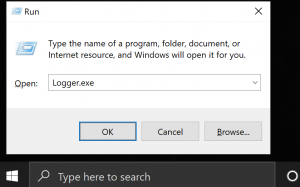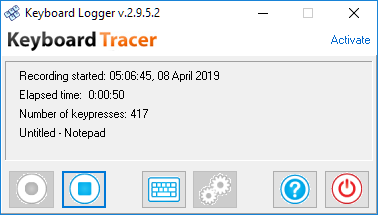A complete tutorial on how to record keystrokes on a computer
A keyboard log can be extremely helpful in hundreds of situations. Monitoring of what employees type can give you clues on possible idlers jeopardizing productivity in your company. Tracking keyboard activity of the corporate server can identify data theft or can be used for forensics purposes. And a keyboard key recorder installed on a home PC warns you if your kids have potentially dangerous conversations in the net.
Keyboard Tracer is a light yet powerful tool to monitor key strokes on a computer. Below you will find a thorough guide on how to use this software to learn what is going on your home or corporate PC.
Contents:
- Installation and Removal instruction
- First use of the Keyboard Tracer
- Launching the Keystrokes Logger
- Configuring the Logger settings
- Stopping of logging and quitting the Keyboard Tracer
- Viewing the Keyboard Tracer LOG
- FAQ and Usage Cases
How to download Keyboard Tracer
Keyboard Tracer if a free-to-download software. This means you can freely download it without registration on our website and use it as long as you need. Please open the download page of our keystroke tracking tool to download the program.
Note that the free trial version is time unlimited but has certain functional limitations. Please learn more at the download page or open the order page to purchase the unlimited version.
Important notice:
Because Keyboard Tracer is updated often, the setup executable you will download may produce a warning message.
Keyboard Tracer is verified by all popular antiviruses and is 100% safe. Also, the program does not install unwanted third-party software or plugins.
How to install Keyboard Tracer software
IMPORTANT! We noticed that there are several sources that distribute the cracked version of Keyboard Tracer software. We have tested each cracked version and found that all of them containing the malware and spyware inclusions. Please do not setup the “cracked versions”, it is not safe! Use official sources such as our website or CNET (download.com) to download the virus-free version.
After your download completes, run the setup executable. Note that sometimes Windows may display a warning message indicating that the downloaded file is potentially risky. As we said above, this is due to frequent updates of the tool. Each update “resets” the number of downloads in Windows SmartScreen and similar tools, so they display the download as risky.
If you see such a message, click “Continue” to start installation.
You should see the first screen of the Setup Wizard:
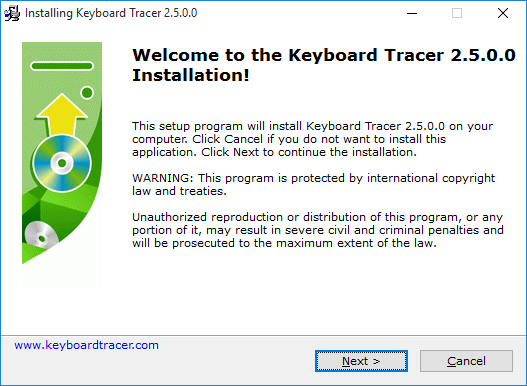
Follow the steps of the Setup Wizard to install our program that monitors keyboard activity on your computer. The installation is pretty simple and self-explanatory. You may select a different destination folder to install the program into, however, we recommend that you proceed with the default path.
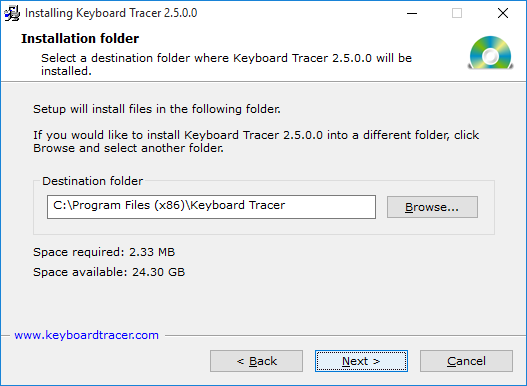
The installation process takes less than a minute. After the setup copies all necessary file, it offers you to configure launch options of Keyboard Tracer. You can start the keyboard tracking software now and select whether you want it to start automatically on this computer on every reboot.
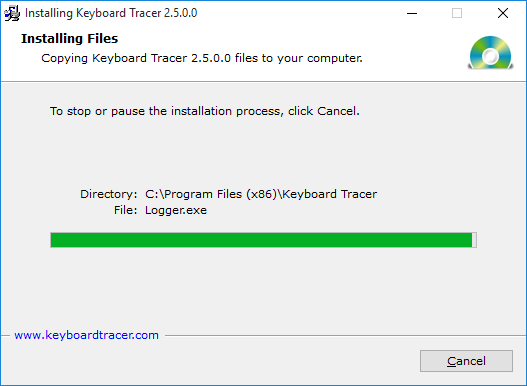
Congratulations! You are now one step away from running the most efficient yet invisible key press recorder.
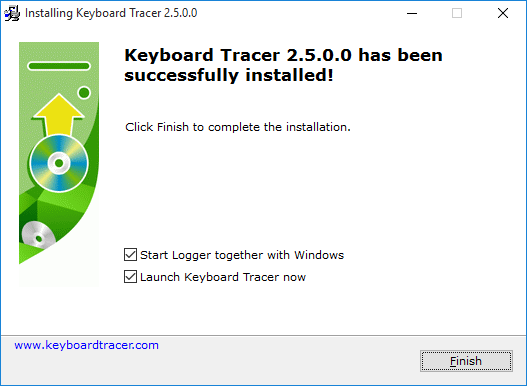
By default the Keyboard Tracer will show the tray icon after startup. If you want to launch Keyboard Tracer hidden, you have to stop the recording, go to settings and disable the tray icon. Memorize the hot-key which will show you the tracer window (Shift+Ctrl+K by default).
Press Finish button to close the setup wizard
How to run keystroke recorder
As soon as the installation process finishes, you can instantly launch Keyboard Tracer by selecting the “Launch Keyboard Tracer now” option. This will execute the program immediately.
Important note to users:
Note that you cannot launch the program from the Start menu or Start screen using the Keyboard Tracer shortcut. The setup program does not create a desktop or Star menu shortcut, because this would be a clear sign for users on that computer that the keystroke history is being monitored.
That is why you shouldn’t disable “Launch Keyboard Tracer now” and the “Start Logger together with Windows” options if you don’t know how to start the program without using a shortcut.
Without a desktop shortcut, you can launch Keyboard Tracer by using the Windows search feature. Type “keyboard tracer” in the search box and select the Keyboard Tracer application in the suggestions to start it.
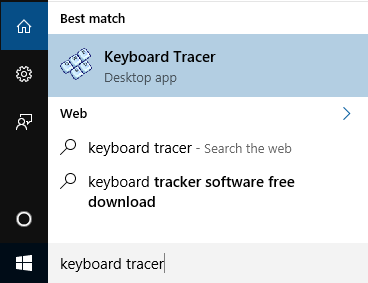
Note to advanced users:
You can run the keylogger using the command line prompt and pass a certain command line parameters to the program. To run Keyboard Tracer from the command line, bring up the Windows command prompt by pressing Win+R and typing the Logger.exe executable name along with the full path to this executable:
The command line parameters are:
- /norun – usually when Keyboard Tracer starts it immediately begins to record keyboard input. However, you may turn off this behavior by using the /norun command prompt parameter.
- /hide – this parameter tells Keyboard Tracer to hide upon start up. This means it will not display a system tray icon making it fully invisible for an end user. Important: when Keyboard Tracer is hidden, you can bring up the main window of the program and start/stop recording keystrokes only by pressing the keyboard shortcut. The default shortcut is Ctrl+Shift+K.
How to use Keyboard Tracer to record keystrokes
Keyboard Tracer is designed to be very intuitive to use, so many functions work automatically on any system without the need to adjust anything. Below you will find a guide on how to record keyboard on your computer, and how to see logs that show what keys are being pressed.
How to record keystrokes on Windows 10, 8, 7, Vista and XP
Normally, Keyboard Tracer starts logging keystrokes instantly after it starts. However, you can change this by disabling the corresponding option (see below). Ok, here is how to track keystrokes with Keyboard Tracer.
How to start recording keystrokes
To begin recording every single key pressed on the keyboard:
- Click the system tray icon or press the keyboard shortcut (Ctrl+Shift+K by default) to open the Keyboard Tracer main window.
- Click the Start recording button to enable recording of all keyboard events in the system. This includes word processors, browsers, messengers, games, chats and so on.
- In the main window you can see some general stats of recorded key presses.
- Click the Close button
to hide Keyboard Tracer window. The program will remain active and working in the background still saving every keystroke.
How to stop recording keystrokes
When you want to disable monitoring of key strokes for a while, do the following:
- Click the system tray icon or press the keyboard shortcut (Ctrl+Shift+K by default) to open the Keyboard Tracer main window.
- Click the Stop button to stop recording of keypresses for a while. The session goes on pause and will continue when you click the Start recording button again.
How to exit Keyboard Tracer and stop tracking keyboard presses
If you want to close Keyboard Tracer and stop recording any keyboard activity, follow these steps:
- Click the system tray icon or press the keyboard shortcut (Ctrl+Shift+K by default) to open the Keyboard Tracer main window.
- Click the Quit button. This will close Keyboard Tracer and will unload it from memory. Note that the program may run again upon next reboot if the “Start Logger together with Windows” option is turned on.
How to view keystroke history (keyboard log)
When Keyboard Tracer monitors keystrokes, it automatically saves them into a log file. Such a log file contains all typing history on the computer for the current session. Each typing session is saved into a separate log file. Here is how you can view keystroke logs:
View the current typing history on a computer in the main window of Keyboard Tracer
- Click the system tray icon or press the keyboard shortcut (Ctrl+Shift+K by default) to open the Keyboard Tracer main window.
- Click the Keyboard log button to open the current typing history log. The log is an HTML file, it opens in your default browser.
- Alternatively, you can view the current log file with recorded keyboard history by right-clicking the system tray icon and selecting “View current log file” item. Apparently, if the system tray window is not shown (i.e. if the program works in the hidden mode), you cannot use this variant.
How to view all saved keystroke logs
If you want to review older logs, not just the current one, you will need to follow these steps:
- Locate the folder where log files are stored in Windows Explorer or any other file manager. If you don’t know what this folder is, read the “How to configure” section below.
- Find the log file you need. The name of each log file is the date when this log file was recorded.
- Double click the log file to open it in a browser.
The opened log file looks as follows:
As you can see, Keyboard Tracer records all key presses and automatically sorts them by application a keypress was detected in. This allows you to easily locate unwanted applications, for instance social networks or disallowed messengers on a corporate computer, or games and adult sites on a home PC.
Also, you see date and time when the recording session started, individual keypress events and the date and time when the recording session was stopped.
How to configure Keyboard Tracer
Want to make your recording of keyboard strokes even more efficient? Keyboard Tracer provides a number of options to customize how and when keyboard activity will be saved.
To bring up the Options windows of Keyboard Tracer:
- Click the system tray icon or press the keyboard shortcut (Ctrl+Shift+K by default) to open the Keyboard Tracer main window.
- If the keyboard type recorder is now active and is tracking key presses, stop it by clicking the Stop
button.
- Click the Settings
button. This will display the options window.
- Now you may press the Start
button to start monitoring your keyboard.
Program settings
This block of settings configures how the program will track keystrokes on the computer. The following options are available:
- Log files location – this parameter specifies where Keyboard Tracer should store recorded logs of key strokes.
- Hotkey to show/hide logger – this option sets the combination of keys you should press to bring up or hide the main window of the program.
- Start automatically when starting Windows – enable if you want Keyboard Tracer to start with each reboot. Otherwise, you will need to run it manually after each restart of the system.
- Show icon in the system tray – if enabled, displays an icon. Clicking this icon brings up the main window, right-clicking the icon brings up the context menu. Disable this option to make the key press recorder invisible.
- Prompt password – if this option is set, Keyboard Tracer will ask for a password. This security option prevents unauthorized persons from accessing keystroke tracker settings and key logs.
Log file settings
Here you can configure what keyboard events should be recorded in log files. For instance, you can disable recording of functional or navigation buttons or enable automatic screenshot taking. Typically, for a home computer you may want to disable logging of most of functional keys to save space and make logs more readable. However, forensics logs or logs of a corporate server may need all keys tracked and recorded.
How to view the Keyboard Tracer LOG
Keyboard starts a new log file every day. To view the log file you need to open the LOG storage folder and find the appropriate file. LOG file can be opened with any web-browser such as Internet Explorer, Opera or FireFox. Depending on the version of Keyboard Tracer you use, you may need an Internet connection for proper display of the LOG file because the LOG file is using the Bootstrap CSS styles.
There are several ways to open and view the keystrokes log:
- Activate the main window by pressing the hotkeys combination, then press the Tracer
button. This will open the current log file in the default web-browser. The same option can be accessed from the try icon pop-up menu.
- Use Windows File Explorer to navigate and open the folder where the log files are stored, then double click to the desired log file. This will open the log file.
- If the tray icon is visible, right click to the Keyboard Tracer icon in the system tray, then click “View current Log file” menu item if you want to open the current log (today log) or click the menu item “Open Log directory” to see all LOG files.
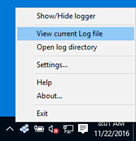
Keyboard Tracer log file opened in the Internet Explorer look like this:
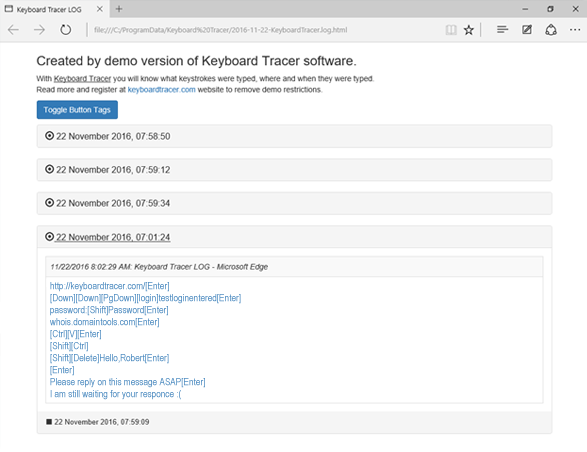
Click here to see the log file example.
The log contains the following information:
- Session Header – Date and time when the log session (recording) was started i.e. when you launched the Keyboard Tracer or pressed the Start
button. Each Session Header is interactive and you can click on the time-stamp to expand or collapse the session log.
- Date, time and the caption (text from the headline) of the program where the keystrokes were pressed.
- List of the keystrokes registered in the specified application including the control keys (button tags). You can hide or show these control keys from the list using the topmost button called “Toggle Button Tags“
- Session Footer – Date and time when the recording session was stopped i.e. Keyboard Tracer was unloaded or when you pressed the Stop
button.
How to uninstall Keyboard Tracer
If you decided to remove our keystroke history software from the computer, follow this instruction:
- Open the Control panel from the Start menu.
- Select Programs and features. If your Control panel is in Category View, click “Uninstall programs” instead.
- Find Keyboard Tracer in the list.
- Select it and click Uninstall.
Keyboard Tracer will uninstall completely, without traces.
Frequently Asked Questions
You may want to read the following guides right after the program setup.
How to track keystrokes on a computer?
Keyboard Tracer was designed exactly for that kind of activity. You simply run it, and it track keyboard and saves ever key press into a log file. Keyboard Tracer may not be the only program that tracks keystrokes, but it combines simplicity with efficiency, so using it is very simple for any computer owner. By default Keyboard Logger shows the noticeable tray menu so the first you should do if you want to hide the fact of the key logging is disable the tray icon . To do that, run the logger, go to the program Settings
, disable the appropriate option and press OK to save settings. That’s it. If the program is configured to start together with Windows, it starts hidden after computer restart. Or you may re-run it hidden manually using the command Logger.exe /hide
How to install Keyboard Tracer secretly?
Keyboard Tracer cannot be installed secretly. The purpose of the program is safety, not spying. So you cannot install it on someone’s computer without letting this person know you did. In fact, you still need physical access to that computer and enough user permissions to install software on it. In most cases it can be installed only at the PC belonging to you or your company. We do not support hidden techniques as it is illegal in most countries.
Are there any limitations in the free version?
While the free trial version of Keyboard Tracer can be used indefinitely, there are some functional limitations in it. Specifically, you can only use the program to record first 1000 keystrokes in each session and each recording session can only last up to 10 minutes. Typically, this is more than enough to test keyboard recorder functionality. In order to use the program without any limitations, please order it here.
The unregistered version shows the following popup message when you start the recording:

I’ve lost my master password. How can I recover access to Keyboard Tracer?
Unfortunately, this is not possible. The program never stores the password in an open form anywhere. Instead, it stores the hash of the password and compares the hash of the original password with the hash of the entered one. In your case this means that we cannot help you recover access to the program. Try remembering the password.
Is this program a keyboard spy?
No. Keyboard Tracer is not a spy. It can work invisibly in the background, but it does not hide itself completely from a user. This means you can freely uninstall it just like any other application. We believe spying is illegal and unethical, so we do not develop such software. However, using Keyboard Tracer you can ensure safety of your kids in the Web, or safety of your business data – these are completely legitimate use cases of Keyboard Tracer.
